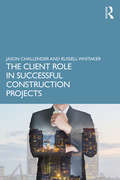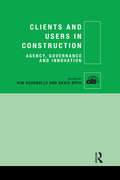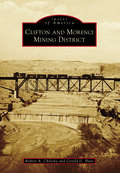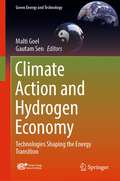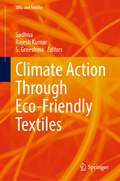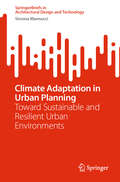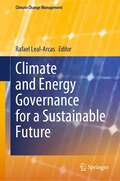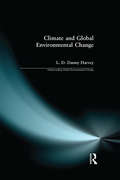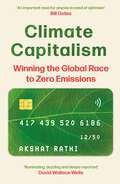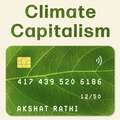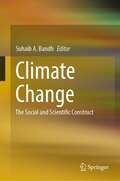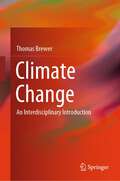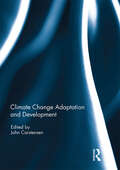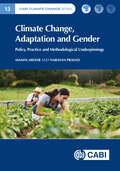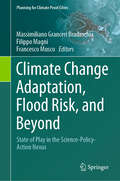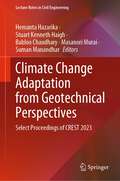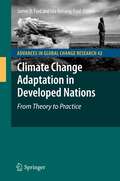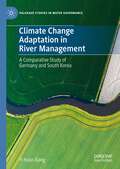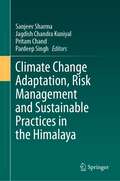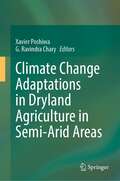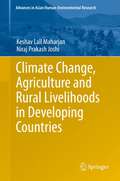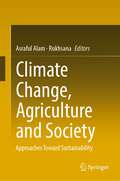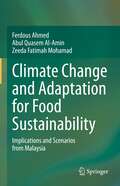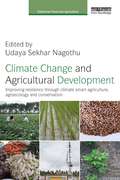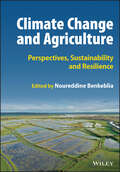- Table View
- List View
The Client Role in Successful Construction Projects
by Jason Challender Russell WhitakerThe Client Role in Successful Construction Projects is a practical guide for clients on how to initiate, procure and manage construction projects and developments. This book is written from the perspective of the client initiating a construction project as part of a business venture and differs from most available construction literature which can externalise the client as a risk to be managed by the design team. The book provides a practical framework for new and novice clients undertaking construction, giving them a voice and enabling them to: Understand the challenges that they and the project are likely to face. Communicate and interact effectively with key stakeholders and professionals within the industry. Understand in straightforward terms where they can have a positive impact on the project. Put in place a client-side due diligence process. Reduce their institutional risk and the risk of project failure. Discover how their standard models are able to co-exist and even transfer to a common client-side procedure for managing a construction project. Written by clients, for clients, this book is highly recommended not only for clients, but for construction industry professionals who want to develop their own skills and enhance their working relationship with their clients. A supporting website for the book will be available, which will give practical examples of the points illustrated in the book and practical advice from specialists in the field.
Clients and Users in Construction: Agency, Governance and Innovation
by Kim Haugbølle David BoydClients have been identified as critical for building delivery but have been under-researched with only a few studies about them. This book seeks to address this gap. A deeper look into the nature of construction clients and their relation to building users exposes more fundamental questions related to the activity of building and the activity in the building. These fundamental questions include 'How do clients get what they want?', 'How do clients cope with the building process?', and 'How are clients being shaped by building(s)?'. This book on clients and users is structured around three main themes: Agency is concerned with the classical agency/structure dichotomy on actions, roles and responsibilities or, put differently, whether actors can act freely or are bound by structural constraints. Governance is related to the interplay between clients and the supply system: clients govern the supply system but are at the same time governed by the supply system through different processes and mechanisms. Innovation deals with construction innovation and what part clients and users play in this struggle between change and stability. The book includes theoretical and conceptual frameworks on what constitutes clients and users as well as case studies on R&D themes of relevance to practice.
Clifton and Morenci Mining District
by Robert A. Chilicky Gerald D. HuntAcross America, from big cities to small towns and rural hamlets, there are many stories of challenges, historic events, courageous people, tragedy, and success. Some of the best and most exciting tales may not be well known. Such is the case for the towns of Clifton and Morenci, Arizona. They survived labor strikes, rising and falling copper prices, devastating floods, outlaws and lawlessness, gambling houses, and saloons. All this added to the lore that these towns were some of the roughest communities in the West. Today, after 143 years of mining, Freeport-McMoRan's Morenci copper mine is the largest in North America. Expansion has required new homes in Clifton-Morenci, a modern library, and recreational facilities. Residents are proud of their communities.
Climate Action and Hydrogen Economy: Technologies Shaping the Energy Transition (Green Energy and Technology)
by Malti Goel Gautam SenThis book focuses on up-to-date progress on the current status of technology and progress in climate action and hydrogen energy in India. It includes contributions from leading experts, and covers emerging topics such as issues & challenges in moving toward hydrogen economy, green hydrogen production technologies, hydrogen production from liquid hydrogen carriers, policy perspectives on hydrogen as energy source of the future, hybrid approaches for solar hydrogen, among others. This book is of interest to those working in academia, industry and policymakers in the field of energy.
Climate Action Through Eco-Friendly Textiles (SDGs and Textiles)
by Sadhna Rajesh Kumar S. GreeshmaThis book covers the latest developments in sustainable textiles and how they can help mitigate the fashion industry's environmental impact. It focuses on innovative textile production approaches by prioritizing eco-friendly materials, responsible sourcing, ethical manufacturing practices, using cutting-edge technology to create textiles that are not only sustainable but also high-performing and durable. This book further explores the wide range of possibilities for reducing the fashion industry's environmental impact, from natural dyeing techniques to biodegradable fibers. This book will be of interest to students, researchers, fashion industry professionals, environmentalists and anyone who is interested in learning more about sustainable fashion.
Climate Adaptation in Urban Planning: Toward Sustainable and Resilient Urban Environments (SpringerBriefs in Architectural Design and Technology)
by Simona MannucciThis book provides an overview of the current planning paradigms and technical strategies to cope with climate change, specifically flooding. Architecture and planning face the challenging task of designing the built environment while addressing complex issues in urban areas. Factors such as climate change, societal and economic issues and population growth can significantly impact the success of a plan. In order to plan for the future, adaptation and flexibility have become crucial. However, the traditional deterministic approach in planning allows no room for failure, expecting plans and projects to achieve desired objectives regardless of how the future unfolds. It also explores new planning paradigms, methods, and tools from other disciplines that can be integrated into urban planning to achieve long-term, flexible adaptation in the face of uncertain conditions (Decision Making Under Deep Uncertainty—DMDU). Additionally, a case study is presented, focusing on addressing uncertainties in a flood-prone area in Rome through scenario planning, combining various cutting-edge model-based methodologies drawn from DMDU. The target audiences are researchers and practitioners in architecture and urban planning.
Climate and Energy Governance for a Sustainable Future (Climate Change Management)
by Rafael Leal-ArcasThis book includes contributions by leading experts across the globe with the first part of the book focusing on the analysis of the Paris Agreement on Climate Change, examines COP26, and questions the political process in the US for the creation of policy for meaningful greenhouse gas emissions reductions. Part 2 explores various ways in which one can effectively mitigate climate change. The contents provide an analysis of carbon pricing, development of specific green energy technologies to promote economic prosperity, and analysis of electric vehicles and other elements of electrification in areas with carbon-intensive electricity supply. Part 3 analyses the international dimension of energy governance (both regional and global) and climate action. It further provides an analysis of the challenges faced by small island developing states, least-developed countries and other vulnerable places. It also offers an analysis of the prospects for a European Energy Union and explores why energy security and decarbonization are significant. Lastly, it explores global energy governance and how its fragmentation can be reduced. This volume will be a useful reference for those in industry and academia.
Climate and Global Environmental Change (Understanding Global Environmental Change)
by L. D. HarveyClimatic change, now more than ever in this age of global warming, is seen as fundamental to the study of the environment. This text examines the importance of climate as one of the major forcing functions in the global environmental change process. It emphasizes both human-induced climatic change and natural climatic change, providing a comprehensive historical context and important projections for the future. It offers a thorough, up-to-date, critical overview of the physical science behind global warming concerns.
Climate Capitalism: Winning the Global Race to Zero Emissions / "An important read for anyone in need of optimism" Bill Gates
by Akshat Rathi'AN IMPORTANT READ FOR ANYONE IN NEED OF OPTIMISM' BILL GATES'DAZZLING AND DEEPLY REPORTED' DAVID WALLACE-WELLS'HIGHLY READABLE . . . ENGAGING STORIES OF PEOPLE BEHIND SOME OF THE MOST IMPORTANT ADVANCES IN RECENT DECADES' PILITA CLARK, FINANCIAL TIMESIt's now cheaper to save the world than destroy it.Our age will be defined by the climate emergency. But contrary to the doomist narrative that's taken hold, the world has already begun deploying the solutions needed to deal with it.On a journey across five continents, Climate Capitalism tracks the unlikely heroes driving the fight against climate change. From the Chinese bureaucrat who did more to make electric cars a reality than Elon Musk, to the Danish students who helped to build the world's longest-operating wind turbine, or the American oil executive building the technology that can reverse climate damages, we meet the people working to scale technologies that are finally able to bend the emissions curve.Through stories that bring people, policy and technology together, Akshat Rathi reveals how the green economy is not only possible, but profitable. This inspiring blend of business, science, and history provides the framework for ensuring that future generations can live in prosperity and that the wheels of progress don't falter.
Climate Capitalism: Winning the Global Race to Zero Emissions / "An important read for anyone in need of optimism" Bill Gates
by Akshat RathiTen inspiring breakthroughs from inside the global race towards zero emissions.It's now cheaper to save the world than destroy it.Our age will be defined by the climate emergency. But contrary to the doomist narrative that's taken hold, the world has already begun deploying the solutions needed to deal with it. On a journey across five continents, Climate Capitalism tracks the unlikely heroes driving the fight against climate change. From the Chinese bureaucrat who did more to make electric cars a reality than Elon Musk, to the Danish students who helped to build the world's longest-operating wind turbine, or the American oil executive building the technology that can reverse climate damages, we meet the people working to scale technologies that are finally able to bend the emissions curve. Through stories that bring people, policy and technology together, Akshat Rathi reveals how the green economy is not only possible, but profitable. This inspiring blend of business, science, and history provides the framework for ensuring that future generations can live in prosperity and that the wheels of progress don't falter.(P)2023 Hodder & Stoughton Limited
Climate Change: The Social and Scientific Construct
by Suhaib A. BandhBeginning in the second half of the twentieth century, the impacts of climate change have been fierce, causing loss of human life and irreparable destruction to natural and man-made infrastructure in many parts of the world.The difference between climate change now and in the past is that of sudden and disproportionate disruption of the natural energy dynamics by the changing consumption patterns of billions of human beings who have polluted terrestrial and aquatic ecosystems. The picture that emerges from the exhaustive analysis of international data drawn from the most reliable sources indicates that we have possibly gained access to the gateway of extinction and it is time that we take corrective steps immediately.Global climate change is further altering our relationship with the environment, modifying relatively stable climatic factors and making them uncertain, unpredictable, and threatening. Changes in land use and an increasing demand for water resources due to climate change have affected the capacity of ecosystems to sustain food production, ensure the supply of freshwater resources, provide ecosystem services, and promote rural multi-functionality. Ensuring food production does not just depend on increasing water efficiency, promoting climate resilient crop production, or reducing land-use competition for urbanization but also on a more suitable and stable climate as the changes in climatic factors like precipitation, temperature, radiation, evaporation, and wind bring about some major shifts in global food supplies. According to Special Report on Emission Scenarios (SRES), focused on greenhouse gas emissions projections, and Representative Concentration Pathways (RCPs) conducted by the Intergovernmental Panel on Climate Change (IPCC), climate change increases the risk of simultaneous crop failures (including corn, rice, legumes, and vegetables) if irrigation systems are not fully adapted to water stress situations. A changing climate could have many adverse impacts on other sectors of our environment. This book offers concrete, up-to-date, and appropriate study cum research material for students, researchers, academicians and policymakers. It will be of a greater interest to students and researchers in the field of environmental science, agriculture science, agronomy, and sustainable development.
Climate Change: An Interdisciplinary Introduction
by Thomas BrewerThis textbook introduces and explains the issues around climate change and its mitigation. It includes topics across disciplines and can be used as a single-volume text by students studying a range of subjects. Among the topics included are: ·How to adopt significant mitigation measures now to avoid the most catastrophic long-term consequences of climate change.·Reducing the rates of highly potent, short-lived emissions of methane gas and black carbon particulates—reductions that are necessary to meet the temperature targets of the Paris Agreements.·Implementing wide-ranging adaptation measures to reduce the deaths and economic costs of extreme heat waves, droughts, wildfires, hurricanes, and floods.·Recognizing the unusually rapid warming in the Arctic, which is disrupting weather patterns in the northern hemisphere and currents in the Atlantic Ocean, causing world-wide sea-level rise, and also causing methane leaks in the Arctic region—leaks that could eventually lead to irreversible global warming consequences. Meeting these challenges effectively requires action by both governments and businesses. The book examines the national and local governmental policies—and business practices—that are needed in sector-specific chapters. An objective of the book is to inform readers about specific problems resulting from climate change—and the wide range of potential government policies and business practices, changes in technologies, and changes in public attitudes and actions that can reduce the emissions and otherwise lessen their impacts. Indeed, a central message is that understanding the issues posed by climate change requires no less than an understanding of climate science, micro- and macro-economics, technologies for mitigation and adaptation measures, as well as politics and law at many governmental levels from local to global. The author has included short case studies that illustrate and integrate multiple analytic perspectives. The book is therefore appropriate for students, professionals, and general audiences with wide-ranging interests and backgrounds.
Climate Change Adaptation and Development
by John CarstensenClimate change is real and it is man-made. We have put so many greenhouse gas pollutants into the atmosphere that we will see significant and long-term change that we need to adapt and adjust to. It is important for development practitioners to understand these impacts and the challenge of how and when to adapt to climate change.There are plenty of grim presentations of what the extremes of the possible climate scenarios will throw at us over the next 100 years, but not all change will be disastrous; some change will be beneficial, but much of the change will happen at an unprecedented rate that will require the best possible analysis and understanding of how and when we should adapt to climate change.This is important for development practitioners as we invest in ensuring that poverty is reduced and eliminated and the well-being of everyone is improved. Many countries and communities around the world are vulnerable to the impacts of climate change, but developing economies may on one hand be less resilient to the impact, but could on the other hand be in a better position to make their development climate smart by making the most efficient use of their economic resources.The chapters in this book shine a light on the complexity and the multi-dimensional aspects of climate change adaptation. They gather some of the experiences of addressing climate change impacts in a development context. This book was previously published as a special issue of Development in Practice.
Climate Change, Adaptation and Gender: Policy, Practice and Methodological Underpinnings (CABI Climate Change Series #17)
by Dr Mamta Mehar Professor Narayan PrasadThis book offers a wide, in-depth study of the gender-climate change-agriculture nexus. The crux of understanding these connections comprises gender equality and tools to measure gender discrimination, the evolution of the concept of gender inclusiveness and its concerns; and the need to address the same by formulating gender-inclusive policymaking. Despite the fact that more than 50 years have elapsed since gender concerns were included in explorations of this nexus, there is still ambiguity around the foundations, connections, and approaches for planning gender-inclusive climate policies. This book aims to clear that ambiguity by: · Being the first to explore exclusively this issue in detail. · Revealing how and why consideration of gender is so important for understanding how climate change impacts rural communities and agricultural systems globally. · Exploring every dimension of climate change (including belief systems and perceptions, knowledge, experience, coping strategies, adaptation, and mitigation strategies) and linking it to gender. It includes new theoretical and methodological approaches that go far beyond the household as the unit of analysis (using various approaches, including intersectional analysis). The book not only throws light on major themes of research, but also covers different methodologies ranging from review methods to mathematical models, conceptual frameworks and empirical analysis. It will be of wide interest to students, scholars, and researchers in gender studies, agriculture, climate change and rural development research, and also to practitioners, extension workers, and planners designing new climate-resilient practices.
Climate Change Adaptation, Flood Risk, and Beyond: State of Play in the Science-Policy-Action Nexus (Planning for Climate Proof Cities)
by Francesco Musco Massimiliano Granceri Bradaschia Filippo MagniThis book includes the insights of a seminar that was held at IUAV University of Venice, on May 29th and 30th featuring 10 speakers. 8 speakers, 2 moderators, and 1 organizer from the seminar, plus 10 other authors contributed to this book. The writers’ expertise spans from local climate adaptation planning, public policy analysis, climate and environmental finance, and climate adaptation advocacy to multi-risk analysis, GIS, disaster risk management, ecosystem services assessment, urban geography, art, and civic engagement. The book contents address adaptation and flood risk mitigation along the Science-Policy-Action path - both theoretical and operative perspectives are discussed. EU climate adaptation policy and finance, climate adaptation implementation, flood risk analysis, nature-based solutions, blue ecosystem services, regional adaptation planning, and critical infrastructure adaptation are the topics investigated in depth by the writers.
Climate Change Adaptation from Geotechnical Perspectives: Select Proceedings of CREST 2023 (Lecture Notes in Civil Engineering #447)
by Hemanta Hazarika Stuart Kenneth Haigh Babloo Chaudhary Masanori Murai Suman ManandharThis book presents select proceedings of the 2nd International Conference on Construction Resources for Environmentally Sustainable Technologies (CREST 2023), and focuses on sustainability, promotion of new ideas and innovations in design, construction and maintenance of geotechnical structures with the aim of contributing towards climate change adaptation and disaster resiliency to meet the UN Sustainable Development Goals (SDGs). It presents latest research, information, technological advancement, practical challenges encountered, and solutions adopted in the field of geotechnical engineering for sustainable infrastructure towards climate change adaptation. This volume will be of interest to those in academia and industry alike.
Climate Change Adaptation in Developed Nations: From Theory to Practice (Advances in Global Change Research #42)
by James D. Ford Lea Berrang-FordIt is now widely accepted that adaptation will be necessary if we are to manage the risks posed by climate change. What we know about adaptation, however, is limited. While there is a well established body of scholarship proposing assessment approaches and explaining concepts, few studies have examined if and how adaptation is taking place at a national or regional level.
Climate Change Adaptation in River Management: A Comparative Study of Germany and South Korea (Palgrave Studies in Water Governance: Policy and Practice)
by Yi hyun KangThis book examines the approaches to climate change adaptation in water governance taken by South Korea and Germany. By comparing their political decision-making processes, this book explores the factors behind their differences. Adaptation to the changing climate is critical to human society and water is the principal medium through which climate change will affect us. Due to high levels of industrialization and population density, flood control is a high priority in both countries’ adaptation plans. While South Korea has maintained its engineering-oriented flood control policy for river management, Germany has turned its direction from its long-standing technical approach to more nature-based solutions. The evidence of this study indicates that policy change and stability is the result of discourse and institutional interaction, and thus emphasizes the validity of discursive institutionalism. This book will clearly explain why certain policies are adopted for water management and will be an invaluable contribution to the expanding literature on the socio-political aspects of climate change adaptation.
Climate Change Adaptation, Risk Management and Sustainable Practices in the Himalaya
by Sanjeev Sharma Jagdish Chandra Kuniyal Pritam Chand Pardeep SinghThis volume analyzes ecological and socio-economic risks due to climate change in the Himalayan mountain ecosystems, communities, and proposes adaptation strategies and sustainability practices. In order to better understand the potential actions required to improve natural resource conservation and the development of mountain people's livelihoods. The authors discuss the current status of local knowledge system on various environmental aspects of conservation and sustainable use of mountain resources in the Himalaya. The book addresses the institutional capacities, gaps, and priority areas of capacity building to strengthen policies and governance in regard to climate change, landuse management, biodiversity conservation, and sustainable management in the Himalayan region. The aim of this book is to enhance coordination building among policymakers, planners, mountain communities to foster collaboration between different stakeholders by understanding local perceptions of climate change as well as variability issues, and establishing adaptation strategies to cope with these impacts. The chapters incorporate theoretical and applied aspects, and may serve as baseline information for the sustainability of mountain ecosystems through the contribution of multidisciplinary and interdisciplinary expertise from the Himalayan region. The book will be useful for students, teachers, and researchers working in different areas pertaining to mountain ecosystems, as well as policymakers and planners working on issues related to the sustainability of the mountain ecosystem.
Climate Change Adaptations in Dryland Agriculture in Semi-Arid Areas
by G. Ravindra Chary Xavier PoshiwaThis book highlights the approaches for achieving trans-disciplinary research integration for “semi-arid dryland agriculture systems” under changing climates, while also identifying the elements of a collaborative research agenda that are needed to advance global food security. The book emphasizes climate change being a reality and how drylands are bearing the brunt in diverse ways. The major impact of dryland agriculture is on communities that need to: avoid the short- and long-term impacts of the changing climate; adapt strategies that can minimize these impacts; and be able to mitigate climate change, for which they need climate smart interventions. These interventions are only realized through knowledge and experience sharing among stakeholders from different sectors and backgrounds. It is in this context that the publication was seen as a necessity in order to bring together ideas that will transform lives and build adaptation capacities, thereby providing the much-needed products in communities leading to development
Climate Change, Agriculture and Rural Livelihoods in Developing Countries (Advances in Asian Human-Environmental Research)
by Keshav Lall Maharjan Niraj Prakash JoshiThis book is about climate change and its relation to agriculture and rural livelihoods. It starts by providing a basic understanding of climate change science followed by the relation of climate change to agriculture, the impact of which is discussed based on the particular impact of climate change on plant and animal physiology. The book further discusses the inclusion of the agriculture sector in various international climate change negotiations. It also reviews the cost and opportunities for agricultural projects through international climate change regimes, specifically the Clean Development Mechanism under the Kyoto Protocol. With this background, the book finally proceeds to an explanation of the methodologies used to assess the impact of climate change on agriculture and empirically discusses its impact on agriculture and rural livelihoods in Nepal.
Climate Change, Agriculture and Society: Approaches Toward Sustainability
by Asraful Alam RukhsanaThis book discusses emerging contexts of global warming and climate change, agricultural vulnerability and adaptation from local to global scale. Climate change, resilience in relation to agriculture and livelihoods and multi-dimensionality of various approaches are clearly taken into account by providing studies and perspectives on various methods and scales based on natural science to social science frameworks. This edited work contains chapters that are interdisciplinary, covering climate change, agriculture vulnerability, disaster impact, productivity efficiency, food security, livelihood resilience, land degradation, sustainability, in terms of plan and perform for transformation, sustainability and adaptation, including philosophy, change and economics, as well as the natural sciences. This book addresses the sustainable development goals to reduce the adverse impacts on agricultural productivity brought on by climate change and its adaptation and disaster risk reduction in developing and developed nations. Some of the assessed challenges include soil erosion, land use conversion, natural resource mismanagement, crop productivity decline and economic stagnation. This book covers important issues in the production and consumption of food in the past and present periods, agriculture, livelihood, and climate change, disaster risk management and society. All of these are under the threat of ongoing climate change and significant challenges to livelihood sustainability. The book is arranged into five broad sections: each part will cover a set of chapters dealing with a particular issue of the climate change, agriculture and society: approach toward sustainability. This book aims to attract attention of students, researchers, academician, policymakers and other inquisitive readers interested in different aspects of climate change, agriculture, livelihood and sustainability, particularly at local to global context.
Climate Change and Adaptation for Food Sustainability: Implications and Scenarios from Malaysia
by Ferdous Ahmed Abul Quasem Al-Amin Zeeda Fatimah MohamadThis book assesses the vulnerability impacts of climate change on food security by examining a 50 years scenario (2015- 2065) and following a top-down approach. Importantly, looking at the sustainable food production, the authors compared the cost-benefit of adaptation costs from 2015 to 2065. It was found that a 15% adaptation capacity is more efficient for Malaysia in order to combat the climate change effects on the food sector. This book has developed a quantitative adaptive model namely, the Malaysian Climate and Economy (MCE) model, based on the dynamic Computable General Equilibrium (CGE) modeling structure to examine food sustainability and adaptation strategies. Malaysia experiences an unusual combination of droughts and extreme rainfall events that can be attributed to climate change. These unusual events and consequences leave Malaysian policymakers looking for ways to make Malaysia self-sufficient in terms of agriculture. It is assumed that climate change effects may result in increasing food insecurity and vulnerability in the future. Policy measures are in place to lessen the likely climatic effects overall, but there is an urgent need to develop an adaptation policy for the future.
Climate Change and Agricultural Development: Improving Resilience through Climate Smart Agriculture, Agroecology and Conservation (Earthscan Food and Agriculture)
by Udaya Sekhar NagothuTwo of the greatest current challenges are climate change (and variability) and food security. Feeding nine billion people by 2050 will require major efforts aimed at climate change adaptation and mitigation. One approach to agriculture has recently been captured by the widely adopted term of "Climate Smart Agriculture" (CSA). This book not only explains what this entails, but also presents practical on-the-ground studies of practices and innovations in agriculture across a broader spectrum, including agroecology and conservation agriculture, in less developed countries. It is shown that CSA is not a completely new science and a number of its recommended technologies have been used for some time by local farmers all over the world. What is relevant and new is ‘the approach’ to exploit their adaptation and mitigation potential. However, a major limitation is the lack of evidence-based knowledge that is necessary for policy makers to prepare strategies for adaptation and mitigation. This book assembles knowledge of CSA, agroecology and conservation agriculture, and perspectives from different regions of the world, to build resilient food systems. The first part analyzes the concept, opportunities and challenges, and provides a global perspective, drawing particularly on studies from Africa and Asia. The second part of the book showcases results from various studies linked to soil, water and crop management measures from an ongoing program in India as well as experiences from other regions. The third section assesses the needs for an enabling policy environment, mainstreaming gender and sime final recommendations for up-scaling and/or out-scaling innovations.
Climate Change and Agriculture: Perspectives, Sustainability and Resilience
by Noureddine BenkebliaClimate Change and Agriculture Authoritative and comprehensive resource covering climate-smart agriculture with key insights into its implementation Climate Change and Agriculture provides a complete overview of the development of sustainable agroecosystems and cropping systems and details how to improve the resilience of cultivated crops and cropping systems to the adverse conditions of the climate, such as drought, increasing levels of carbon dioxide, global warming, and many other secondary effects such as soils fertility depletion, uncommon disease, and pests. Additionally, the text suggests different agricultural practices to face the severity of frequency of the natural events. Climate Change and Agriculture also delves into the different climate-resilient methods and climate-smarter agriculture (CSA) for food production by building healthier soils through different sustainable practices, redesigning diverse agroecosystems, and developing new crop varieties, livestock breeds, and farm practices. Insight into how modern technology has affected the field, and how it may affect the field in the future, is included. Other topics discussed in Climate Change and Agriculture include: Climate change and agriculture (state of the art, challenges, and perspectives), plus studies on crop yields and their extreme value analysis over India Symbiosis for food security and sustainability in changing climate and emerging issues related to conservation agriculture in Africa The role of periurban agriculture in sustainability and climate change, with additional information on nutrient management in agro-ecosystems Soil fertility management and biofertilization in changing climate and biochar mitigating abiotic stress-induced damages under changing climate For academics and students; seed, fertilizer, and chemical producers; farmers and farming communities; and policy makers, Climate Change and Agriculture contains invaluable insights into the subject that are helpful in understanding the current state of the field and preparing for potential future developments.
